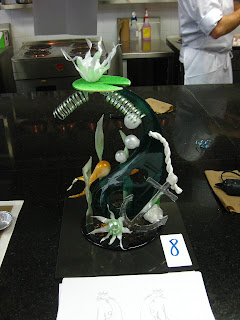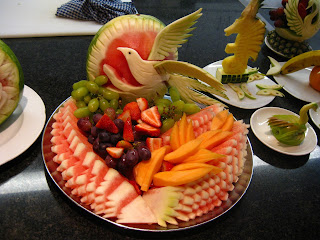Superior Pastry is arguably
all about the sugar work. It is the most
advanced thing we learn, and many students continue through Superior
specifically to get some experience pulling sugar. We saw a sugar demo in Intermediate (one Chef
Eric gave us towards the end of the semester just for kicks), but now we were
finally to the real deal. After the
chocolate bonbons, it was Sugar Time.
The sugar portion of
our education comes in three parts over two weeks: One class for pastillage and a little
practice (and to get over the initial shock of the high working temperature of
isomalt); one practice run of the Sugar Exam, during which we construct a Sugar
Showpiece and the Chef gives critiques about the design and execution; and the
Sugar Exam.
Leçon 107
For the first time,
Chef Hervé gave us a straightforward list of the requirements for our Sugar
Showpiece. We had to know, because the
pastillage we would make in Practical 107 would be the exact same pastillage we
would use in our Sugar Exam. He had been
avoiding telling us, because he didn’t want us to get distracted while we were
supposed to be working on our Chocolate Showpiece. Lesson 107 was the pastillage demo, and it
went really well. We learned how to make
it, a white fast-drying dough that can be used to build hard-as-a-rock sugar
components. It is opaque, so it adds a
nice design element to our mostly-transparent Sugar Showpieces. Chef also demoed a few different sugar
flowers and the best technique for a sugar ribbon.
 |
| Chef's pulled sugar demo |
 |
| A pulled sugar daisy: one of four flowers the chef taught us how to pull |
The practical was our
chance to get adjusted to working with sugar.
We spent the first hour making and shaping our pastillage
components. I had spent the previous few
days working on the sketch for my Sugar Showpiece, and I am so glad I brought
it to class! I made a whole tray of
pastillage leaves, barnacles, ropes, fish, and lily pads…everything I thought I
could possibly want on my showpiece, making sure I had at least three of
everything (to account for the practice exam and possible breakage). The rest of the class was spent cooking and
working with isomalt, a sugar substitute that is slightly less susceptible to humidity. The flowers took a lot of trial and error for
me, but I finally got one decent-looking rose.
The ribbon was much easier for most of us (to the surprise of Chef
Hervé), so I made a really cute, shiny sugar bow.
 |
| My tray of pastillage. Everyone thought my lily pads were Pac Men. That anchor is made of compressed sugar, and it didn't work out. But it was worth a try! |
 |
| My first successful sugar rose...I knew I needed to practice at home before the exam |
 |
| My shiny sugar bow! |
Leçon 108
Chef Hervé was out of
town with a few of our classmates who were competing in the Canadian Youth
Skills Competition, so Chef Jocelyn gave us our Sugar Showpiece demo in Lesson
108. He showed us all of the required
elements for our exam: a poured base, a
poured main piece (shaped however we like), three flowers (including at least
one rose), leaves, a ribbon, and some pastillage. Every other technique (including the blown
sugar that I was determined to do) was worth extra points. Quite a few things went wrong in the demo (things
that just happen sometimes), but Chef handled it like a pro! He used the pastillage from Chef Hervé’s demo
the previous week, and at the end of class he addressed our many questions
about the practice exam that would take place in the next two days.
 |
| Chef Jocelyn's sugar showpiece |
My mom was in town
speaking at a conference, and she was staying with us! It was great fun, and she graciously fielded design
questions I bounced off of her about my final sketch. I had been practicing blown and pulled sugar
at home, and it was really fun to show her what I planned to do in 3D.
 |
| Practicing pulled roses at home |
 |
| Practicing blown fish at home: I really wanted one on my final piece! |
Chef Hervé was back
just in time for our practical class, and I couldn’t be more excited to get
started! I really believed in my design,
and practicing so much at home had me determined to produce something
beautiful. Months before, I had visions
of using an anchor in my sculpture, so I ultimately ended up with an
underwater-themed design that included a blown sugar fish and a huge pastillage
lily pad. I made my own anchor mold out
of a square sheet of silicone, and I hoped it would work out…but I wasn’t
really sure it would.
The practical was so
much fun, and it went really well for me.
The main poured piece turned out much darker than I had envisioned, but
it grew on me, and the anchor mold was fine.
I had plenty of time, so I worked at a cautious pace to be sure I didn’t
break much. After everyone had finished
and walked their sculpture down a few stairs, through three doors and around
three corners, Chef gave comments on every piece in front of the entire
class. It was good to hear everyone’s
comments so clearly, and to see everyone’s different designs. When it came to my sculpture, Chef said, “La
Petite Erin...Good Job! I like
this. Keep the colors. Good shape.
Ribbon, very nice. This (the
flower with the green center) is beautiful!
One thing: pull sugar a little
more. Nice work.” I was so happy with his critique, and was
excited to show Mom and Chad my work!
They had seen first-hand how nervous I was when I left for class that
afternoon.
 |
| It was fun to see all the different designs we came up with using the same materials and techniques! |
Mom and Chad met me at
school to pick me up and sneak a peak of my piece. Unfortunately, we weren’t able to go inside
to take a look (the building was locked), but I suspected as much, so after we
had finished and everyone had left, Robyn (my classmate) and I returned to the
showpieces to take nice photos of ours. It
was a successful day, and Mom and Chad had fruit salad and supper waiting for
me when we got home.
 |
| My first Sugar Showpiece!! (From the front) |
 |
| From the side |
 |
| From the back |
Leçon 109: Sugar Exam
Between the practice
exam and the Sugar Exam, Chad and I went home for a week (Mom got on the same
planes as us!), but that’s a different post all-together.
Since we had already
seen the Sugar Showpiece demo, Chef Hervé gave us a wedding cake demonstration
to accompany our sugar exam. It was
casual and fun, though many students complained that we wouldn’t be making a
wedding cake in practical. Chef even
told us about a French wedding tradition in which family and friends plant a
tree in the house of the newlyweds. They
put a stork or a baby on top of the tree, and if a baby comes within a year of
marriage, the couple has to chop the tree down.
If they wait at least until their first anniversary, the tree gets to
live. Interesting, huh?
 |
| The French and American aesthetics are a bit different when it comes to wedding cake, bit it was a really fun demo |
Although the practice
exam had gone so well for me, I was still pretty nervous for the Sugar Exam
itself. It composes 20% of my final
grade, and with sugar, things can go wrong so easily. I made a few small changes to my sketch,
mostly concerning the scale, and I practiced a little more at home.
Regardless of my
nerves, the practical went really well.
I took my time again, being sure to make extras of my flowers and
bubbles and fish, and it was actually kind of leisurely. Chef Jocelyn was in the practical, and he
often stopped at my station and complimented my tiny fan (I brought it from
home to help with my sugar blowing), my spirals, and my flowers. Chef Hervé stopped at my station and
complimented my work now and then, too, which was great encouragement.
When it was finished, I
was so proud! The colors were different
from the first time (as Chef warned us they would be), but it was nice. We didn’t get comments this time, but I am
confident that I did a good job. My
little anchor worked out, and I know I’ll continue to do sugar work in the
future, even if it’s just in my leisure.
 |
| We get graded on how much our sculpture resembles our sketch. I think mine look pretty close! (sorry it's sideways...not sure how to fix that) |
 |
| Chef Jocelyn really liked this flower |
 |
| Success! |
 |
| The back |






















































